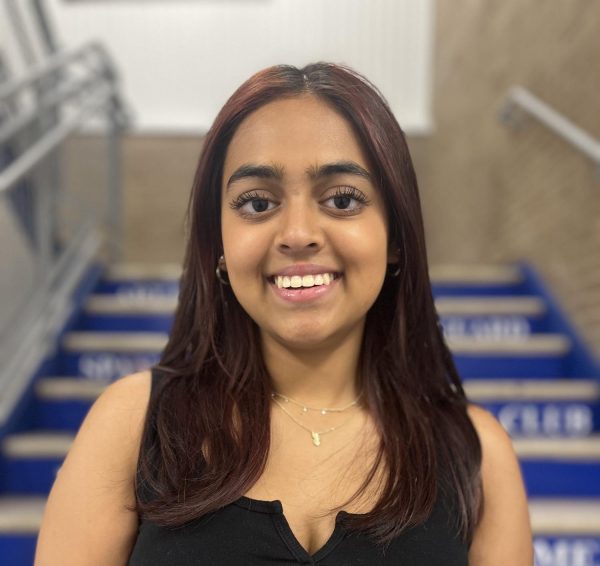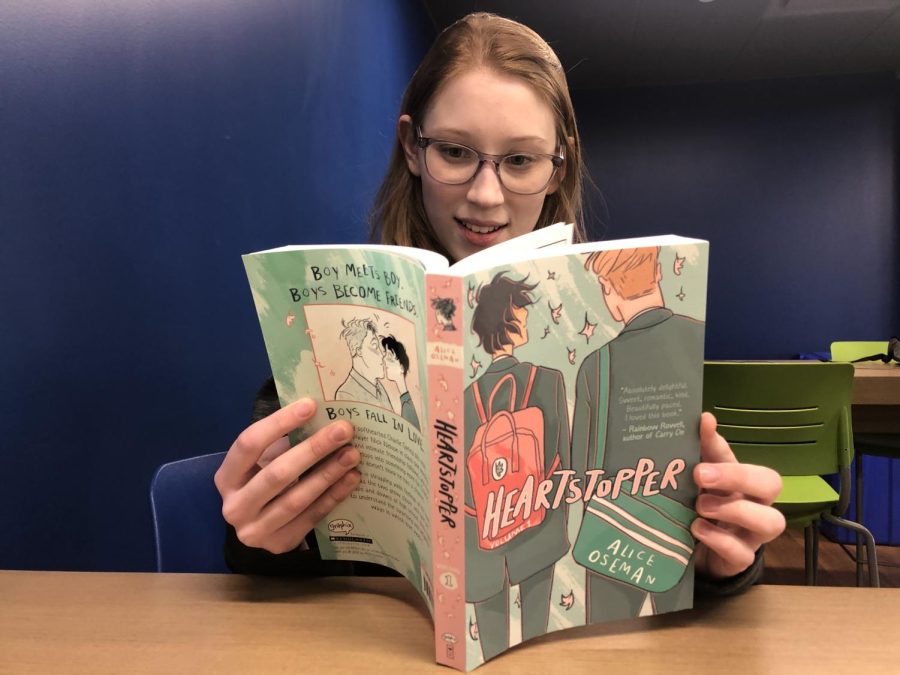Pride and prejudice
LGBTQ+ representation in media
Photo by Sashrika Shyam
Annie Moriarity, junior, reading the graphic novel Heartstopper. Heartstopper is widely loved in the LQBTQ+ community, and showcases the love between two teenage boys and the struggles they undergo.
From Tik Tok to YouTube to Netflix, different forms of media have become an integral part of daily life. These platforms are used for entertainment purposes, but they have also been increasingly used to spread awareness of social issues, particularly in the LGBTQ+ community.
These platforms have been very important in educating people about queer rights and informing people about the trials the community faces. According to Annie Moriarity, junior, who uses she/they pronouns, there has been an increase of LGBTQ+ representation in the media.
“I have seen an increase in LGBTQ+ in the media, like with Instagram allowing you to add pronouns,” Moriarity said. “If I’m not sure of someone’s pronouns, but I don’t want to ask them if I’m not close to them or something. I could just check [their Instagram], which is really nice to just be able to do quickly and make sure I’m not misgendering anyone.”
Moriarity, who identifies as bisexual, finds that her social media platforms, such as Instagram, show her LGBTQ+ content because that is what she searches for most. However, she also believes that social media has promoted the community’s voices.
“For [platforms] like Instagram, there’s just much more access than let’s say publishing a book,” Moriarity said. “To share your story through a book is a lot more complicated than sharing your story through a post, there are much more steps involved and it takes more time.”
Similar to Moriarity, Joey Richards, junior, who identifies as queer, has seen an increase of queer representation in film and TV shows.
“The film and television industries have done an exceptional job over the past few years in including gay people in their projects,” Richards says. “Streaming networks, such as Netflix and HBO Max, have made efforts to boost LGBTQ+ material towards general audiences.”
However, Moriarity finds that while the increase in representation has been positive overall, there are some negative outcomes.
“I think sometimes there’s a lot of pressure put on the community, with added representation there is pressure for that representation to be perfect, when that’s not necessarily true,” Moriarity said. “[The representation] obviously doesn’t need to emulate real life perfectly. Because humans aren’t perfect, no one is. No one’s story is completely perfect.”
Richards also believes that while the increase in LGBTQ+ representation has been very positive, there has been an increase in hatred online.
“Overall, representation has done many great things for the gay community, and has helped to normalize queer relationships in society. However, with more representation there are also more opportunities for hate to spread,” Richards said. “People take any opportunity they can to look down on gay people, even if they’re just minding their own business. If you don’t want to see gay people in [the] media, that’s on you, not them.”
While it is important to acknowledge these negative outcomes, there have been many successful attempts to provide LGBTQ+ representation in the media.
“I think that a show like [Heartstopper] is a big thing for the community to just watch together and see and bring us together and fangirl over the show,” Moriarity said. “ I also think it showed people who may not necessarily have been aware that certain things can happen when you come out or you’re forced to come out or question your sexuality.”
Heartstopper is a TV show that is based on graphic novels authored by Alice Oseman. The show follows Charlie Spring, who is trying to navigate school while being openly gay, and Nick Nelson, who is struggling to come to terms with his sexuality. As USA Today puts it, “this kind of subtle, simple representation [in Heartstopper] is also important. It is a pretty typical high school story of teen crushes and emotions. It’s just about a group of LGBTQ teens.”
Amanda Lagerlof-Perez, freshman, who identifies as bisexual, also prefers this type of subtle representation in the media.
“I Am Not Okay With This [is a show I like]. And the main character in that is a lesbian, but it’s not like, ‘ooh’ pride flags in your face,” Lagerlof-Perez said. “It really is a very good story. And I think that’s good for representation.”
Similar to Lagerlof-Perez, Kota Jirasek, freshman, believes that brands and larger corporations should work to incorporate LGBTQ+ representation into their yearly advertising.
“A lot of companies do Pride collections in June, but not during any other month,” Jirasek said. “I think that’s pretty good [representation], but I think that companies could advertise LGBTQ+ couples all year around, instead of advertising [only in] June itself.”
In addition to stereotypes promoted by companies, Lagerlof-Perez also has seen an increase in homophobia on social media platforms.
“I think that a lot of times in social media, anything you put out there is going to be judged, and especially people who are brave and talk about their experiences,” Lagerlof-Perez said. “It’s kind of inevitable that they’ll get hate comments. And I can see how that can be discouraging or negatively impact other people who see that kind of stuff.”
While Lagerlof-Perez has seen an increase in negative comments around the community, Moriarity has a different perspective.
“I think representation is helping people kind of push through [homophobia, although] people are obviously still going to be bigots,” Moriarity said. “I feel like there’s not so much an increase in homophobia or transphobia, I think we just see it more because it’s at the tips of our fingers.”
To try and combat this hatred, Richards recommends ways for people who are not in the LGBTQ+ community to become more educated and less ignorant.

During her third and final year on the Bear Facts staff, Sashrika is looking forward to assuming her role as LZ Life Editor and Social Media Manager. When...

